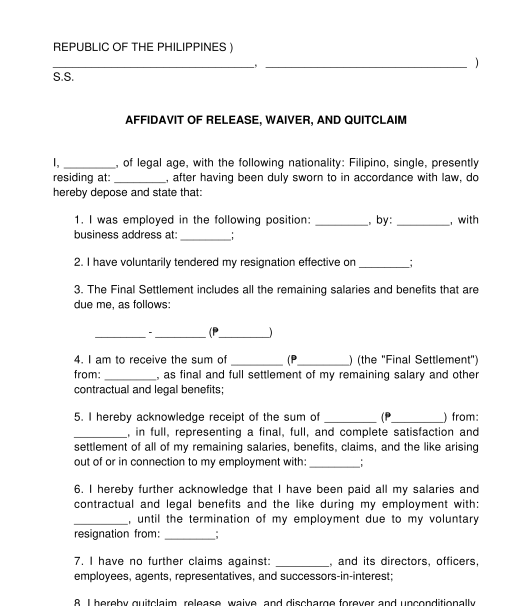 09/07/2025
09/07/2025

Answer a few questions and your document is created automatically.

Your document is ready! You will receive it in Word and PDF formats. You will be able to modify it.

 09/07/2025
09/07/2025
 Word and PDF
Word and PDF
 2 to 3 pages
2 to 3 pages
What is an Affidavit of Release, Waiver, and Quitclaim for Employment?
An Affidavit of Release, Waiver, and Quitclaim for Employment is used when an employee voluntarily resigns from employment. Once an Affidavit of Release, Waiver, and Quitclaim is signed by the employee, the employee can no longer file a case in court after resignation, or will not ask for any more salary from the employer after receiving his final pay which includes all remaining salaries and other contractual and legal benefits. In other words, the employer gives up the right to claim anything from the employer.
The following are the different types of Quitclaims:
Is it mandatory to have the Affidavit?
There is no legal requirement to have the affidavit but this will serve as a protection on the part of the employer against possible claims that the employee may bring to the courts against the employer by reason of the employee's resignation.
What are the effects of signing the Affidavit?
When an employee resigns from employment, they are usually given a "final pay" which includes all remaining salaries and other contractual and legal benefits that the employee has earned but has not yet received.
When the final pay is given or will be given to the employee upon signing this affidavit, the employee will no longer have any claims against the employer.
What are the prerequisites of the Affidavit?
A requirement before the execution or signing of an Affidavit of Release, Waiver, and Quitclaim for Employment is that the employee must have received the final pay arising from his resignation, or at least the signing of this document and payment of the final pay is made at the same time. The final pay should include the payment of unpaid salaries and benefits.
To be valid between the employer and employee, it is important that the employer ensures the employee is properly informed that he can no longer ask for anything from the employer and that the final pay consists of all the payments that the employer should give to the employee after his resignation.
Who signs the Affidavit?
The employee who resigned must sign the affidavit. Note that the employee must be of legal age to be able to sign the document. Note further that two witnesses if there are any must also sign the affidavit.
What has to be done once the Affidavit is ready?
Once the document is completed, at least three original copies should be printed, then the employee should review the document to see if all the information is correct. The employer should also explain the contents of the document to the employee. Specifically, the employer should explain that, in signing the Affidavit of Release, Waiver, and Quitclaim, the employee will be waiving any and all claims that they may have against the employer. The explanation should be in a language or dialect that the employee understands.
The employee together with the two witnesses must personally appear before a notary public and present at least one current identification card (I.D.) issued by an official agency bearing the photograph and signature of the affiant. The employee must swear under oath the whole truth of the contents of the affidavit and then sign all copies of the affidavit. The affiant will be asked to leave one original copy for the files of the notary public, and the two other original copies should be kept by the employee and the employer. Once notarized, the affiant may use the Affidavit as needed.
Which documents should be attached to the Affidavit?
If desired, the following could be attached to the Affidavit :
Is it necessary to notarize the Affidavit for it to be valid?
Yes, because an Affidavit of Release, Waiver, and Quitclaim for Employment is a sworn statement that should be executed or signed in the presence of a notary public. If it is not notarized, there may be a risk on the employer's part that the employee will just deny that his final pay has been paid after his resignation.
No. However, if there will be witnesses at least two witnesses should sign the affidavit at the time it is acknowledged before a notary public so that other persons can prove the existence of the agreement between the employer and employee under the affidavit. This protects the principal and the agent in the following ways:
Note that witnesses to the Affidavit must be independent and disinterested, meaning they must have nothing to gain from being a witness. This means the witnesses cannot be the other employees of the employer, close family members of the employee, or other persons with close relationships with either the employer or the employee.
What are the costs involved in the finalization of the Affidavit?
Notarization fees for an Affidavit of Release, Waiver, and Quitclaim for Employment are typically PHP100 to PHP500.
What must the Affidavit contain?
The affidavit should contain the following information:
Which laws are applicable to an Affidavit of Release, Waiver, and Quitclaim for Employment?
There are no laws that apply specifically to an Affidavit Release, Waiver, and Quitclaim for Employment however, jurisprudence and the Labor Code of the Philippines may apply.
You fill out a form. The document is created before your eyes as you respond to the questions.
At the end, you receive it in Word and PDF formats. You can modify it and reuse it.
Guides to help you
Country: Philippines